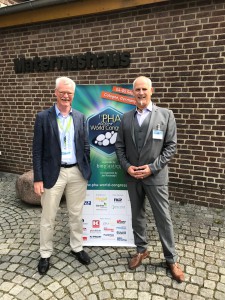Polyhydroxyalkanoates or PHAs are a group of polyesters (a platform) produced in nature by numerous microorganisms, specifically bacteria, who use them as energy storage. PHAs are natural polymers with thermoplastic properties and have unique properties such as biodegradability in almost any environment, even in the ocean. They can be designed to have extremely different properties and can be used in numerous applications.

Deutsche Fassung: https://renewable-carbon.eu/news/quo-vadis-phas-vor-allem-die-kunststoffpolitik-wird-ueber-ihre-zukunft-entscheiden/
Since more than 20 years, research institutes, start-ups and established chemical companies try to produce improved PHAs for specific applications and introduce them to the market. But commercial success is still limited: The global capacities might be around 80,000 t, distributed among many small producers. The actual production is even less and was estimated to be 10,000 to 20,000 tonnes in 2017. Plastics that break down easily, even in the sea, would actually be ideal for combating the increasing plastic waste streams, especially in light of the growing ocean pollution and microplastic problem. So what are the barriers to true success?
A visit at the “1st PHA platform World Congress”, 4-5 September in Cologne, Germany was an eye opener. With an impressive number of 165 participants, almost every developer, producer, compounder and user in the field of PHAs was present and shared his latest technologies and marketing strategies. For long, this had been a dream of Michael Thielen, publisher of the bioplastics MAGAZINE and Jan Ravenstijn, a world leading expert on PHAs and other bio-based polymers. Now their dreams were more than fulfilled.
So, quo vadis PHAs? It was impressive to see how far developed PHA varieties have become and how many different applications can be covered by the flexibility and multitude of properties PHAs can provide. Jan Ravenstijn opened the congress with his presentation “Dealing with the opportunities and challenges on the PHA-platform”. He gave a comprehensive overview on the more than 40 PHA producers worldwide and on examples of PHA-product applications in thermoplastics and thermosets, in durable and one-time use articles and in replacement opportunities of bulk and engineering polymers.
Market leaders Kaneka (JP) and Danimer Scientific (USA) displayed not only a wide range of PHA varieties and properties, but also certificates from TÜV Austria and DIN Certco on the biodegradation in different environments, such as in-home composting, soil, fresh water or even the ocean. Kaneka revealed plans to expand their PHA production to 5,000 t/year in 2019.
The most developed PHAs are HBH (P(HB-co-H); Poly(3-hydroxybutyrate-co-3-hydroxyhexanoate)) and PHBV (P(HB-co-V); Poly(3-hydroxybutyrate-co-3-hydroxyvalerate)), , which again offer a wide range of applications. They can be used for mulch films, for dolly ropes and nets in fishery, and even as glue for fish feed. Other applications are films (for packaging), coating, industrial glues, cosmetics, consumer goods with injection moulding and 3D printing (FKuR (DE) and Helian Polymers (NL)). Some companies also presented applications for construction and textile fibres (“soft, cool, smooth”, Centexbel (BE) and Mango Materials (USA)) and for tissue engineering in medical implants (AMIBM DE/NL). Finally, agricultural fertilizers can be coated with PHA to optimize nitrogen release (Pursell Agri-Tech, USA). All these applications and even more are already, at least in small volumes, in commercial use.
The PHA producing bacteria digest sugar, starch or plant oil to produce PHAs. Several projects were presented to use organic waste water streams for the PHA production to reduce costs. This is economically more interesting than the subsidised production of biogas as long as there is sufficient demand. Paques and Phario from the Netherlands have big plans to produce PHBV from waste water and their first demonstration project will start in 2019.

An interesting approach was presented by the Chinese company Bluepha: They utilize unique PHA-producing microorganisms that survive even in salt water and have programmed them beyond standard metabolic engineering to improve yields, to simplify the separation of their P3HB4HB (P(3HB-co-4HB); Poly(3-hydroxybutyrate-co-4-hydroxybutyrate)) from the remaining biomass and to achieve much lower manufacturing cost.
The biopolymer compounders Biotec (DE) and Modified Materials (NL) mentioned key challenges of PHAs:
- Price – at approx. 4 €/kg, PHAs are considerably more expensive than conventional mass polymers. The use of organic waste water could reduce the costs.
- Consistent properties in different deliveries.
- Improvement of performance.
- Approval for food contact.
- Aging of the materials.
Different policy and strategy presentations (Ellen MacArthur (UK), FullCycle Bioplastics (USA), nova-Institut (DE) and Narocon (DE)) demonstrated that the future of the PHA platform depends mainly on future political and social acceptance. Is the platform part of the solution to the plastic waste problem, or is it part of the problem? Different examples from California legislation, Greenpeace reports and European Commission plastic and waste strategies show concerns about biodegradable plastics as a solution. Hundreds of brands and companies have a clear target for their future plastic use: 100% of all plastics should be reusable, recyclable or compostable. But what will be the share of biodegradable plastics in comparison to recycling?
If PHAs can lead to a regained confidence in biodegradable plastics as part of the solution, they will create access to huge markets. To achieve this, transparent and solid information and documentation are necessary, without making more promises than the materials can keep. The PHA sector needs convincing case studies and the right applications, e.g. where collection and recycling are not possible and PHAs create benefits that other materials cannot offer. Comprehensive use of certifications for various organic degradation standards (industrial, home, soil, marine) are crucial (OWS (BE)) to regain trust.
The first World Congress on PHAs was enthusiastically received by the industry. It was exactly what the players needed in the PHA puzzle. New contacts were made, old ones refreshed and joint projects started: Four people have teamed-up to make a proposal to the congress delegates for a global PHA-platform industry association.
The companies are prepared to produce PHAs of suitable qualities and in sufficient quantities. They want to make their contribution to solving environmental problems. But the bridge to politics and society has yet to be built in order to recognise and realise the full potential of the PHA platform.
Some PHA producers and compounders can be found here: http://bio-based.eu/ibib/?c50
Press release as PDF file: 18-09-18 PR PHA Conference Report
Source
nova-Institut GmbH, press release, 2018-09-18.
Supplier
bioplastics MAGAZINE (Zeitschrift)
Bluepha
DaniMer Scientific
DIN CERTCO Gesellschaft für Konformitätsbewertung
Jan Ravenstijn Consulting
Kaneka Corporation
nova-Institut GmbH
TÜV AUSTRIA Group
Share
Renewable Carbon News – Daily Newsletter
Subscribe to our daily email newsletter – the world's leading newsletter on renewable materials and chemicals










